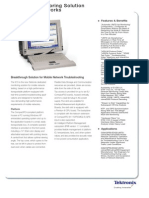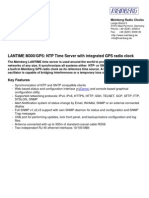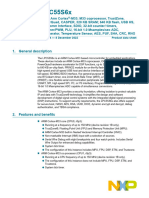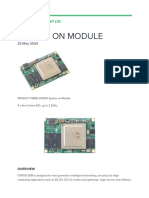Alcatel-Lucent Omnipcx Enterprise: Ip Touch Security: NGP
Alcatel-Lucent Omnipcx Enterprise: Ip Touch Security: NGP
Uploaded by
issa galalCopyright:
Available Formats
Alcatel-Lucent Omnipcx Enterprise: Ip Touch Security: NGP
Alcatel-Lucent Omnipcx Enterprise: Ip Touch Security: NGP
Uploaded by
issa galalOriginal Description:
Original Title
Copyright
Available Formats
Share this document
Did you find this document useful?
Is this content inappropriate?
Copyright:
Available Formats
Alcatel-Lucent Omnipcx Enterprise: Ip Touch Security: NGP
Alcatel-Lucent Omnipcx Enterprise: Ip Touch Security: NGP
Uploaded by
issa galalCopyright:
Available Formats
Alcatel-Lucent OmniPCX Enterprise
IP Touch Security: NGP
All Rights Reserved © 2009, Alcatel-Lucent 1
OBJECTIVE
To describe de the IP Touch Security in case of New Generation Platform
Alcatel-Lucent OmniPCX Enterprise – IP Touch Security: NGP
Ref. ENTP0534P26TEUS Issue 02
IP Touch Security
Solution historical
The IP Touch Security Solution offered the possibility to secure the “signaling
and voice” over IP in Stand-Alone configuration at its first launching
z A SSM(1) is required to secure the CS CPU
z And a MSM(2) is required to secure a MG (Crystal or Common hardware)
z The IP Touch handles themselves the security feature
A second step of development allowed to secure IP ABCF Network links
(Signaling first, then Signaling + Voice)
Then, this Thalès solution has been chosen to respond to some customers who
wanted a strong and reliable signaling link against DOS(3) attacks for remote IP
Media Gateways (Common hardware)... The Thalès VPN Client is embedded on
the GD(4) and only encrypts the signaling
z This GD is then called “MGSec”
The release 9.1 introduces the possibility to secure a MG without Thalès boxes
(NGP Crystal & Common hardware) for Signaling & Voice. The Thalès VPN Client
is embedded on both platforms boards
All Rights Reserved © 2009, Alcatel-Lucent 2
1) SSM: Server Security Module. In case of Call Server duplication, A SSM can be used per CPU
2) MSM: Media Security Module. According to the box generation [MSM or MSM-RM (Rack Mounted)] and the topology, a MSM can
protect a GD (or GD + GA) or an INTIPA/B (or two INTPA/B)
3) Deny Of Service
4) This solution does not require a MSM to protect the GD
Alcatel-Lucent OmniPCX Enterprise – IP Touch Security: NGP
Ref. ENTP0534P26TEUS Issue 02
NGP Security
A NGP board always controls the authenticity of the binary even if the security
mode is “Bypass”(1)
z The binaries are signed with the Alcatel-Lucent private key. The boards use
the Alcatel-Lucent public key stored in their flash to authenticate the files.
This authentication control ensures that the binary has been produced by
Alcatel-Lucent
z The integrity control uses the “SHA-1” HMAC method(2) for NGP boards
The new NGP hardware capabilities offer the possibility to handle the security
functionalities without any MSM(3) . The security level of this solution is the
following one:
z Signaling encryption: AES-CBC(4)
z Voice encryption: SRTP(5) and SRTCP
Terminology
z SoftMSM: NGP Media Gateway(6) running the embedded Thalès VPN client and
the Thalès SRTP library (available as of i1.605.14e)
All Rights Reserved © 2009, Alcatel-Lucent 3
1) In the previous release the GD authenticated its binary only if the security feature was activated (“Security=Protect” in the
lanpbx.cfg file). The crystal INTIP board did not support this authentication
2) The MD5 method is still used for classical Common hardware (GD-GD2/MGSec)
3) A SSM is still required to protect the Call Server. The MSM are not used to protect the NGP Media Gateways
4) Advanced Encryption Standard (AES) cipher Algorithm - in Cipher Block Chaining (CBC) Mode
The packet authentication uses the HMAC-SHA-1 method
5) The voice encryption is realized with the AES-CM cipher [Advanced Encryption Standard (AES) cipher Algorithm - in Counter Mode
(CM)]
6) It includes both types of platforms: Common and Crystal hardware
Alcatel-Lucent OmniPCX Enterprise – IP Touch Security: NGP
Ref. ENTP0534P26TEUS Issue 02
SoftMSM Media Gateway
Initialization
To initialize the IP-Link with the CS, the NGP boards use a PSK key at the
ISAKMP(1) phase (used to authenticate the equipment)
z Like a MGSec, the SoftMSM MG uses a PSK key (PSKg2) different than the one
used by the SMs and IP Touch
This PSKg2 key is derivate from some data of the NGP secured binaries(2)
{ Like the MGSec case, it is possible (recommended) to customize the SoftMSM key because
the NGP boards binaries are transmitted in clear data (TFTP is not encrypted)
{ The Customization Center has to be used to generate this key. This key is called: PSKmg
When the authentication phase is realized, the SoftMSM MG establishes a
permanent IPSec tunnel with the CS (Main + Stand-by CPUs)(3)
All Rights Reserved © 2009, Alcatel-Lucent 4
1) ISAKMP: Internet Security Association and Key Management Protocol
2) The SSMs also own this data, that allows them to generate the same default PSKg2
3) Those addresses are retrieved from the “lanpbx.cfg” file
Alcatel-Lucent OmniPCX Enterprise – IP Touch Security: NGP
Ref. ENTP0534P26TEUS Issue 02
IP Touch Security Solution
Licenses
Different licenses are used to control the system configuration
z “325 IP Touch Security Engine”: allows or not the IP Touch security feature
z “326 Secured IP Touch Phones”: number of potential secured IP Touch Sets
z “327 IP Touch Security MSM”: number of MSM
z “343 MgSec Max Number”: number of MGSec
z “348 Soft MSM Lock (new)”: number of NGP secured Media Gateways
If a GD3 is managed as a SoftMSM, the lock counts for “1”, this counter is not
incremented for all associated GA3 boards (from the same MG)(1)
The management of a Crystal rack with INTIPa/b boards counts for “1” (what ever
the number of INTIP boards)
All Rights Reserved © 2009, Alcatel-Lucent 5
1) If a GD3 (as for a GD/GD2) is connected behind a MSM, this lock is not incremented
Alcatel-Lucent OmniPCX Enterprise – IP Touch Security: NGP
Ref. ENTP0534P26TEUS Issue 02
IP Touch Security Solution
Restriction
z When an INT-IP3 A is managed as a SoftMSM, only one compression daughter
board can be used
So 60 compressors max (instead of 120)
Recommendation
z It is strongly recommended to realize at least one full startup of the NGP
boards without encryption before switching them to SoftMSM mode
All Rights Reserved © 2009, Alcatel-Lucent 6
Alcatel-Lucent OmniPCX Enterprise – IP Touch Security: NGP
Ref. ENTP0534P26TEUS Issue 02
You might also like
- Alcatel-Lucent Omnipcx Enterprise: Ip Touch Security: NGP ConfigurationDocument5 pagesAlcatel-Lucent Omnipcx Enterprise: Ip Touch Security: NGP Configurationissa galalNo ratings yet
- Alcatel-Lucent Omnipcx Enterprise: NGP: New Generation PlatformDocument11 pagesAlcatel-Lucent Omnipcx Enterprise: NGP: New Generation Platformissa galalNo ratings yet
- Man DCM 0010Document18 pagesMan DCM 0010NAMELESS ASHENNo ratings yet
- St4sim 110mDocument24 pagesSt4sim 110mminami.jiro.87No ratings yet
- HSM I&O Manual 1270A513-3 PDFDocument202 pagesHSM I&O Manual 1270A513-3 PDFrzaidi921No ratings yet
- ACOS GSM 64J-AustriaCardDocument2 pagesACOS GSM 64J-AustriaCardgaborkNo ratings yet
- Embedded Security: Product GuideDocument8 pagesEmbedded Security: Product GuidechvenkatwNo ratings yet
- Alcatel-Lucent Omnipcx Enterprise: Ip Touch Security: NGP MaintenanceDocument4 pagesAlcatel-Lucent Omnipcx Enterprise: Ip Touch Security: NGP Maintenanceissa galalNo ratings yet
- NXP Smartmx Smart Java Cards Jcop 75017515Document2 pagesNXP Smartmx Smart Java Cards Jcop 75017515hyddel003No ratings yet
- Acosgsm32J: Java Technology Garbage CollectionDocument2 pagesAcosgsm32J: Java Technology Garbage CollectiongaborkNo ratings yet
- Tektronix Monitoring Solution For Mobile NetworksDocument9 pagesTektronix Monitoring Solution For Mobile NetworksOdunlami OluwatomiNo ratings yet
- Linux Kernel Security Kca09Document72 pagesLinux Kernel Security Kca09wanna_acNo ratings yet
- Cluster Tests ProcedureDocument3 pagesCluster Tests ProcedureVikas RanaNo ratings yet
- GSM Security Master Thesis - Intermediate Presentation: Johann Betz 14.01.2011Document25 pagesGSM Security Master Thesis - Intermediate Presentation: Johann Betz 14.01.2011schwandreNo ratings yet
- Multi Level Security Based Access Control SystemDocument3 pagesMulti Level Security Based Access Control Systemprashant goreNo ratings yet
- NTA5332 - NTAG 5 Boost - 544733 - Rev33Document133 pagesNTA5332 - NTAG 5 Boost - 544733 - Rev33SuBaRu GTNo ratings yet
- Microcontroller (AT89S52) Based Remote Notice Board Using GSMDocument72 pagesMicrocontroller (AT89S52) Based Remote Notice Board Using GSMAkshayNo ratings yet
- Smartcard Mcu With t2g+ Authentication LibraryDocument2 pagesSmartcard Mcu With t2g+ Authentication LibrarymikonforeverNo ratings yet
- DM 00Document13 pagesDM 00sloko2No ratings yet
- TMG6250-G2K Rev08Document4 pagesTMG6250-G2K Rev08Alex SharkNo ratings yet
- Advanced Security Encryption Key Programming Guide For Latticeecp2S, Latticeecp2Ms, and Latticeecp3 DevicesDocument22 pagesAdvanced Security Encryption Key Programming Guide For Latticeecp2S, Latticeecp2Ms, and Latticeecp3 Deviceschengchung liNo ratings yet
- intel-sgx-snort-intrusion-detection-system-finalDocument21 pagesintel-sgx-snort-intrusion-detection-system-finalalgorithme13No ratings yet
- OXE Hardware DescriptionDocument39 pagesOXE Hardware DescriptionIoryogi Kun50% (2)
- Woot17 Paper ObermaierDocument11 pagesWoot17 Paper ObermaierTu BeeNo ratings yet
- USIM - Spec. - ModifiedDocument11 pagesUSIM - Spec. - ModifiedAsif HossainNo ratings yet
- AN12366 - Memory Configuration and Scalable SecurityDocument23 pagesAN12366 - Memory Configuration and Scalable SecuritySuBaRu GTNo ratings yet
- Info - Lantime m300 Gps PDFDocument5 pagesInfo - Lantime m300 Gps PDFvdaNo ratings yet
- PR1602017987EN Quad 10G Encryption Transponder DataSheetDocument4 pagesPR1602017987EN Quad 10G Encryption Transponder DataSheettrojanlightNo ratings yet
- AN12714Document12 pagesAN12714john doeNo ratings yet
- 09+Cellular+Generations+ UpdatedDocument28 pages09+Cellular+Generations+ UpdatedMandanr2No ratings yet
- Gprs Shield sld33149p PDFDocument35 pagesGprs Shield sld33149p PDFAnonymous BkmsKXzwyKNo ratings yet
- Ijirt147104 PaperDocument4 pagesIjirt147104 PaperDurga bhavani JampaniNo ratings yet
- AT-iMG626MOD: Modular, Ethernet Intelligent Multiservice Gateway For Outdoor DeploymentDocument3 pagesAT-iMG626MOD: Modular, Ethernet Intelligent Multiservice Gateway For Outdoor DeploymentOscar RuizNo ratings yet
- Ss 7Document57 pagesSs 7Hammadi GharsNo ratings yet
- Selective Audio Encryption For WMSNDocument6 pagesSelective Audio Encryption For WMSNnaresh19788No ratings yet
- C/OS-II Real Time Kernel Port For Cirrus Logic EP93xx PlatformDocument4 pagesC/OS-II Real Time Kernel Port For Cirrus Logic EP93xx PlatformSrinivasulu_My_835No ratings yet
- f109 nx-sl3 Safety Cpu Unit Datasheet enDocument13 pagesf109 nx-sl3 Safety Cpu Unit Datasheet enЕвгений ФокинNo ratings yet
- 1 03crypto - Hugo KrawczykDocument41 pages1 03crypto - Hugo Krawczyksuraj singhNo ratings yet
- LPC55S6x: 1. General DescriptionDocument140 pagesLPC55S6x: 1. General DescriptionFernando GómezNo ratings yet
- Amec India Tech Som Proposal PDFDocument4 pagesAmec India Tech Som Proposal PDFmeraj01amecNo ratings yet
- GSM SecurityDocument36 pagesGSM Securityradislamy-1No ratings yet
- f109 nx-sl3 Safety Cpu Unit Datasheet enDocument12 pagesf109 nx-sl3 Safety Cpu Unit Datasheet enkrzysztof.zapertNo ratings yet
- ZXUR 9000 GSM Base Station Controller Spare Parts List: Operator LogoDocument12 pagesZXUR 9000 GSM Base Station Controller Spare Parts List: Operator LogomoslemNo ratings yet
- f124 nx-sl5 Safety Cpu Unit Datasheet enDocument13 pagesf124 nx-sl5 Safety Cpu Unit Datasheet enЕвгений ФокинNo ratings yet
- Info Lantime m900 GpsDocument5 pagesInfo Lantime m900 GpsmacjolasNo ratings yet
- MAX-NG Access Release NoteDocument8 pagesMAX-NG Access Release NoteAnonymous fnFwazyI100% (1)
- Safety NX CIP Datasheet EN 201811 S73I-EDocument23 pagesSafety NX CIP Datasheet EN 201811 S73I-Exaxij36723No ratings yet
- MX-ONE I&M (Cap. 1)Document15 pagesMX-ONE I&M (Cap. 1)José IbañezNo ratings yet
- AiMX Platform Whitepaper-230906Document34 pagesAiMX Platform Whitepaper-230906yibamod165No ratings yet
- Security Technology For SAE/LTEDocument4 pagesSecurity Technology For SAE/LTEmkyriaaNo ratings yet
- Connection SecurityDocument52 pagesConnection SecurityQuangHuyĐoànNo ratings yet
- NXP Java Card p5cc080Document18 pagesNXP Java Card p5cc080hyddel003No ratings yet
- How To Order A Cisco As5350 Universal GatewayDocument8 pagesHow To Order A Cisco As5350 Universal GatewayNalog NalogaNo ratings yet
- Nielsen Watermarks Encoder - 3G (NWE3G) : Product OverviewDocument6 pagesNielsen Watermarks Encoder - 3G (NWE3G) : Product OverviewpostharshaNo ratings yet
- TpmfailDocument17 pagesTpmfailWGiraldoNo ratings yet
- Siemens s55 ManualDocument33 pagesSiemens s55 ManualFrancesca MazzolaniNo ratings yet
- JetCombo 3 1834852Document5 pagesJetCombo 3 1834852RICHARDRUBINSTEINNo ratings yet
- Filed Crypto DeviceDocument2 pagesFiled Crypto DeviceeravadheshNo ratings yet
- Echo on a Chip - Secure Embedded Systems in Cryptography: A New Perception for the Next Generation of Micro-Controllers handling Encryption for Mobile MessagingFrom EverandEcho on a Chip - Secure Embedded Systems in Cryptography: A New Perception for the Next Generation of Micro-Controllers handling Encryption for Mobile MessagingNo ratings yet
- PLC: Programmable Logic Controller – Arktika.: EXPERIMENTAL PRODUCT BASED ON CPLD.From EverandPLC: Programmable Logic Controller – Arktika.: EXPERIMENTAL PRODUCT BASED ON CPLD.No ratings yet
- Alcatel-Lucent Free Desktop: Detailed Service DescriptionDocument4 pagesAlcatel-Lucent Free Desktop: Detailed Service Descriptionissa galalNo ratings yet
- Alcatel-Lucent Omnipcx Enterprise Communication Server: Call Recording InterfacesDocument55 pagesAlcatel-Lucent Omnipcx Enterprise Communication Server: Call Recording Interfacesissa galalNo ratings yet
- Alcatel-Lucent Omnipcx Enterprise Communication Server: Smartcall Version 1.0.X - User GuideDocument27 pagesAlcatel-Lucent Omnipcx Enterprise Communication Server: Smartcall Version 1.0.X - User Guideissa galalNo ratings yet
- Alcatel-Lucent Omnipcx Enterprise Communication Server: Iptouch Doorcam - Installation GuideDocument35 pagesAlcatel-Lucent Omnipcx Enterprise Communication Server: Iptouch Doorcam - Installation Guideissa galalNo ratings yet
- Alcatel-Lucent Omnipcx Enterprise Communication Server: Ip Attendant Softphone - Installation and Administration GuideDocument64 pagesAlcatel-Lucent Omnipcx Enterprise Communication Server: Ip Attendant Softphone - Installation and Administration Guideissa galalNo ratings yet
- Alcatel-Lucent Omnipcx Enterprise Communication Server: Smartcall Version 1.0.X - Installation GuideDocument66 pagesAlcatel-Lucent Omnipcx Enterprise Communication Server: Smartcall Version 1.0.X - Installation Guideissa galalNo ratings yet
- Alcatel-Lucent Omnipcx Enterprise: Ip Touch Security: NGP MaintenanceDocument4 pagesAlcatel-Lucent Omnipcx Enterprise: Ip Touch Security: NGP Maintenanceissa galalNo ratings yet
- Alcatel-Lucent Omnipcx Enterprise: Attendant On Ip TouchDocument4 pagesAlcatel-Lucent Omnipcx Enterprise: Attendant On Ip Touchissa galalNo ratings yet
- Alcatel-Lucent Omnipcx Enterprise: Attendant On Ip TouchDocument10 pagesAlcatel-Lucent Omnipcx Enterprise: Attendant On Ip Touchissa galalNo ratings yet
- Alcatel-Lucent Omnipcx Enterprise: Lldp-MedDocument7 pagesAlcatel-Lucent Omnipcx Enterprise: Lldp-Medissa galalNo ratings yet
- Technical and Financial Proposal - Cloud Computing Hosting ServiceDocument5 pagesTechnical and Financial Proposal - Cloud Computing Hosting Serviceissa galalNo ratings yet
- Test and Improve Your Chess With 50 Instructive Grandmaster GamesDocument264 pagesTest and Improve Your Chess With 50 Instructive Grandmaster Gamesissa galal100% (2)
- Malnad College of Engineering, HassanDocument48 pagesMalnad College of Engineering, Hassangowdanischith03No ratings yet
- Symmetric Encryption, DES, AES, MAC, Hash Algorithms, HMACDocument76 pagesSymmetric Encryption, DES, AES, MAC, Hash Algorithms, HMACMukesh86% (7)
- Quantum Cryptography - Wikipedia, The Free EncyclopediaDocument5 pagesQuantum Cryptography - Wikipedia, The Free EncyclopediaDebashish PalNo ratings yet
- NCP RN Win Exclusive Entry Client 11 21 r43671 enDocument8 pagesNCP RN Win Exclusive Entry Client 11 21 r43671 enJohn SimonNo ratings yet
- Cryptography Session 2020 v1Document98 pagesCryptography Session 2020 v1GlmNo ratings yet
- AES T-Box SlidesDocument35 pagesAES T-Box SlidesAhmad RushdanNo ratings yet
- Deploying and Managing Certificates: ContentsDocument39 pagesDeploying and Managing Certificates: ContentsBobe DanutNo ratings yet
- Roblox 230KDocument4,507 pagesRoblox 230Kgroberskiw5No ratings yet
- History of EncryptionDocument5 pagesHistory of EncryptionGaurav SharmaNo ratings yet
- Conventional EncryptionDocument14 pagesConventional EncryptionekalveNo ratings yet
- Hacking Smartcards and RFIDDocument46 pagesHacking Smartcards and RFIDDennis Flynn100% (4)
- Encryption in ASEDocument6 pagesEncryption in ASEkethelnegiNo ratings yet
- Parallel ComputingDocument6 pagesParallel ComputingAsfa SaadNo ratings yet
- MIT15 S12F18 Ses3Document24 pagesMIT15 S12F18 Ses3Nikhil PatelNo ratings yet
- Infoformation Security Lec Symmetric and Asymmetric CryptographyDocument25 pagesInfoformation Security Lec Symmetric and Asymmetric CryptographyBSCS4M1033- Muhammad AbdullahNo ratings yet
- UNIT - III Assignment QuestionsDocument3 pagesUNIT - III Assignment QuestionsramNo ratings yet
- Chapter 8Document9 pagesChapter 8mad maranNo ratings yet
- Homework 1 - Lista 2Document9 pagesHomework 1 - Lista 2Vinayak ChachraNo ratings yet
- Unit-III - E-Commerce and Its ApplicationDocument90 pagesUnit-III - E-Commerce and Its ApplicationVasa Vijay100% (1)
- Crypto 2Document42 pagesCrypto 2MoNo ratings yet
- Chapter 2Document10 pagesChapter 2cudarunNo ratings yet
- Is CombinedDocument566 pagesIs Combinedlolzcat3454No ratings yet
- Crypto Graphy Unit 4Document17 pagesCrypto Graphy Unit 4radhe shamNo ratings yet
- Secret Seed PhraseDocument4 pagesSecret Seed Phraseanodamy100% (1)
- 802.1x WhitepaperDocument6 pages802.1x WhitepaperMatt HnatojkoNo ratings yet
- 18CSE354T - Network Security - Question BankDocument55 pages18CSE354T - Network Security - Question Bankalgatesgiri100% (1)
- CPS GovCA Final V1 0Document56 pagesCPS GovCA Final V1 0Bizimana GilbertNo ratings yet
- Performance Analysis of Security Algorithms For Iot DevicesDocument4 pagesPerformance Analysis of Security Algorithms For Iot DevicesSagar JayanthiNo ratings yet
- Ciena Waveserver Ai Rel 1.3 Common Criteria Guidance DocumentDocument37 pagesCiena Waveserver Ai Rel 1.3 Common Criteria Guidance DocumenttiagomonsoresNo ratings yet
- Presentation ICT TanishkaDocument5 pagesPresentation ICT TanishkaTanishka GoyalNo ratings yet




































































































